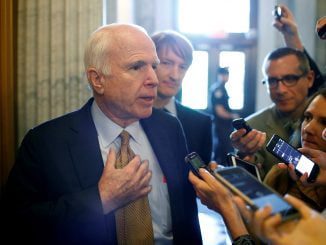
WASHINGTON, D.C. — The U.S. Senate passed its version of a $700 billion defense policy bill on Monday, backing President Donald Trump’s call for a bigger, stronger military.
The Republican-controlled chamber voted 89-8 for the National Defense Authorization Act for fiscal year 2018, or NDAA, which authorizes the level of defense spending and sets policies controlling how the money is spent. The House of Representatives passed its version with a similar spending level in July.
The Senate bill provides about $640 billion for the Pentagon’s main operations, such as buying weapons and paying the troops, and some $60 billion to fund the conflicts in Afghanistan, Iraq, Syria and elsewhere. According to Sen. Richard Burr (R-N.C.), the increase is intended to help military leaders better plan for future operations and boost training and readiness.
“I understand the wide range of threats that face our nation and how versatile our military must be to fight them,” said Burr. “We cannot stand idly by as Iran, North Korea, Russia, ISIL, al-Qaida and others present a threat to the United States. For the previous eight years, our warfighters have been tasked to accomplish an increasingly large range of missions without the necessary resources to do so.”
The 1,215-page bill includes a wide range of provisions, such as $8.5 billion to strengthen missile defense, as North Korea conducts nuclear weapons and ballistic missile tests.
In addition, the Armed Services Subcommittee on Personnel, chaired by Sen. Thom Tillis (R-N.C.), pushed through an across the board 2.1 percent pay raise for service members and expanded eligibility in the military’s TRICARE health plan to allow National Guard and reservists to purchase it.
With readiness and training a primary concern for military brass, the bill also contains about $358 million for construction projects on military installations in N.C.
An amendment to the bill, sponsored by Burr, requires that on-base child care centers be held to the same quality standards and employee background checks as other federal child care facilities.
The two versions on the NDAA must be reconciled before Congress can consider a final version. Th bills increase military spending beyond last year’s $619 billion, defying “sequestration” spending caps set in the 2011 Budget Control Act. A fight over spending is expected because Senate Democrats have vowed to block increases in funds for the military if spending caps on nondefense programs are not also eased.
Sen. John McCain, the Republican chairman of the Senate Armed Services Committee, has been shepherding the legislation through Congress as he undergoes treatment for an aggressive type of brain cancer.
Arguing for increased spending, McCain said more men and women in uniform are dying in avoidable training accidents than in combat. “Where’s the outrage? Where’s our sense of urgency to deal with this problem?” he asked before the vote.
Since June, more than 70 U.S. service members have either been killed or injured in training or noncombat accidents, ranging from two naval collisions in Asia to a Marine Corps transport plane crash in rural Mississippi.
“It’s because of a thing called sequestration, and our failure over the last eight years to make sure our military is prepared, equipped, trained,” McCain said.
Defense Secretary Jim Mattis said on Monday that he is looking into a possible link between the spate of recent military accidents and budget caps, but said he could not draw a direct line at this time.
“I am not willing to say right now that there is a direct line between sequestration and what has happened. I am willing to say … we are going to take a very close look at that,” Mattis told reporters.
Mattis said that he was looking at a number of broader issues to try and explain the large number of accidents, including whether there were cultural issues in the military.
“We are almost hardwired to say ‘can do’ — that is just the way we are brought up,” Mattis said. “But there comes a point in peacetime where you have to make certain you are not always saying we’re going to do more with less.”
FY18 Military Construction Budget for N.C.
Camp Lejeune – $258.09M for upgrades to living quarters and essential facilities
Cherry Point – $15.671M – for a F-35B Vertical Lift Fan Test Facility
Seymour Johnson $26.4M – for facilities to support a squadron of KC-46 Air Force Tankers moving to the base
Fort Bragg – $57.778M for improvements to Special Operations Command training and facilities
______________
North Carolina Total
$357,947,000
Figures are from the U.S. Senate’s National Defense Authorization Act passed on September 18, 2017



